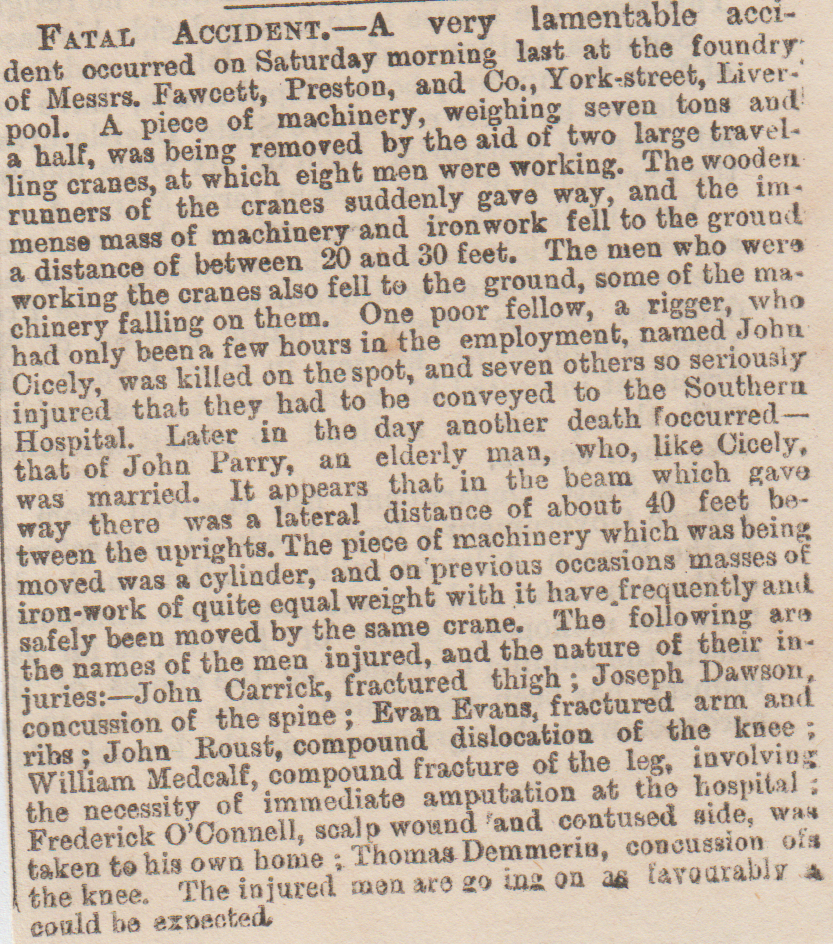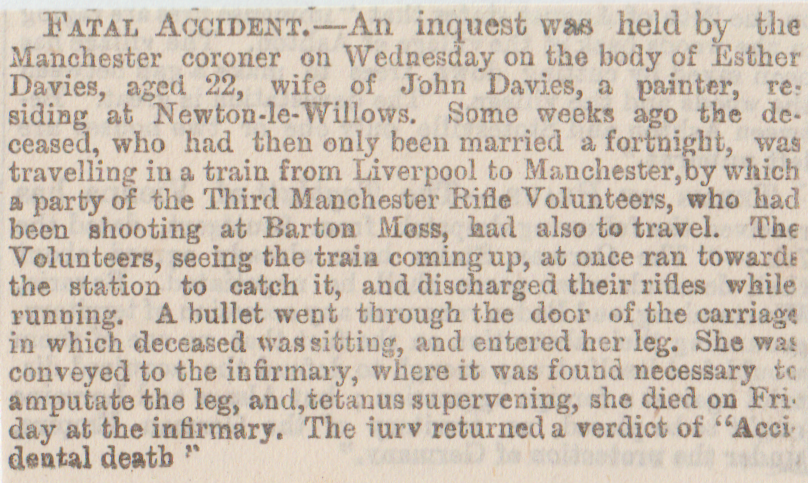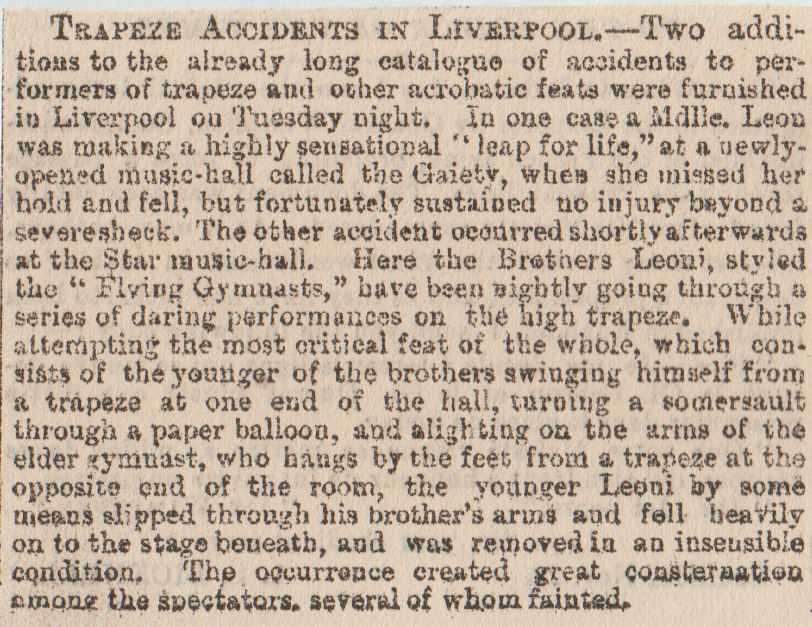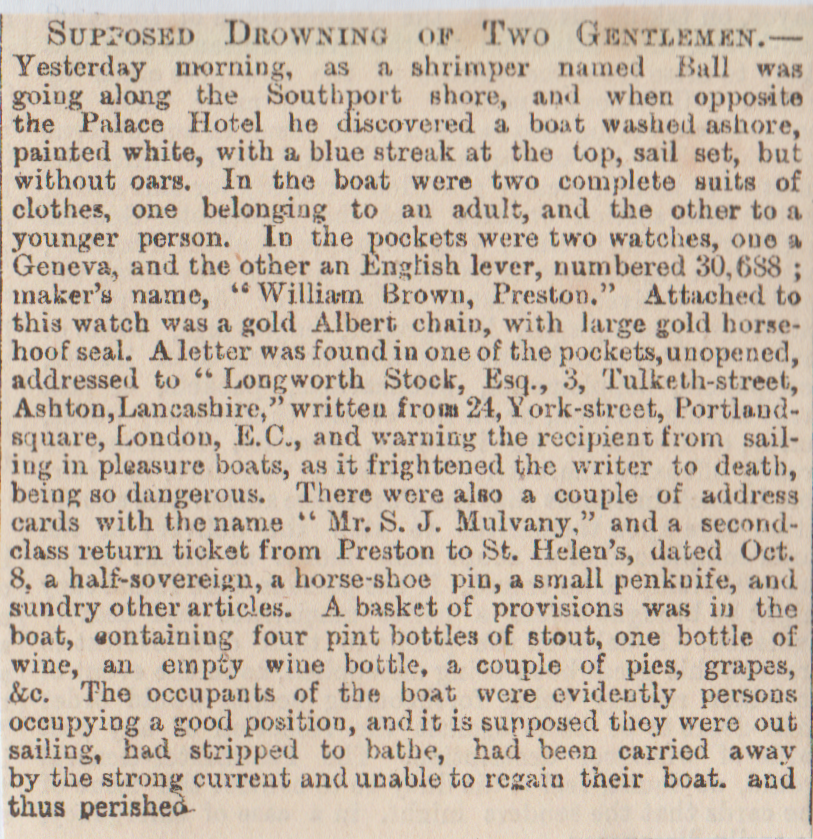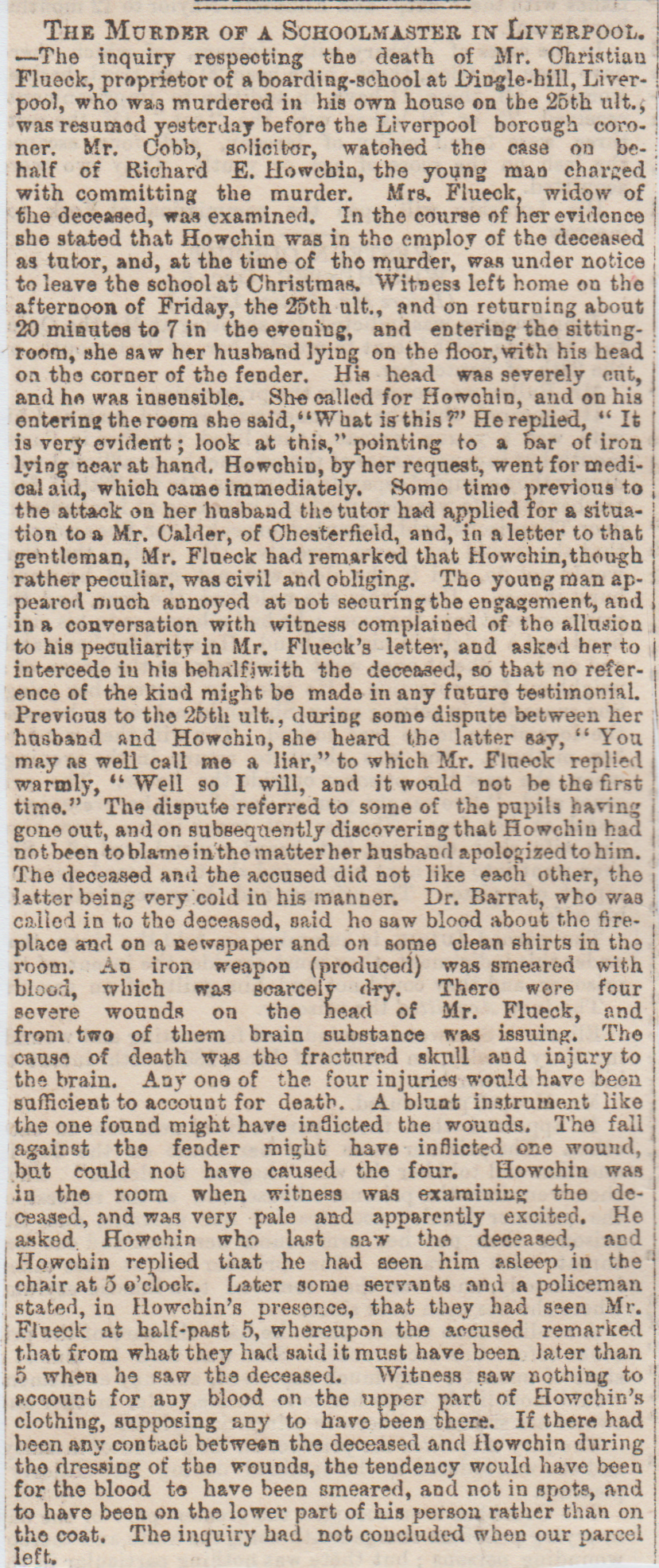1/ Southport, (Boy Hanging in Playground) October 1900
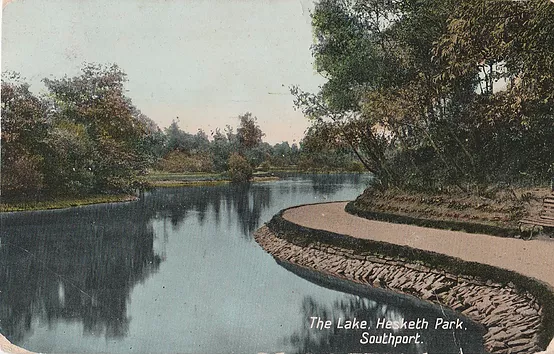
A body of an 11-year-old boy was found hanging to one of the parallel bars in a school playground. A female teacher was summoned, but it seems to have been an accident. The boy’s name was Fernihough and the playground is situated in Preston Road, Hesketh Park in Southport.
2/ Liverpool, April 1889 (Smithdown Road Cemetery Suicide)
61-year-old Anthony Purcell, a sea captain, was playing whist at his home, Holyrood House, Salisbury Road in Wavertree and he had seemed in good spirits that night. The next morning he told his wife he wasn’t feeling too good (he had a heart problem) but he got dressed and left the house. He made his way down to the cemetery at Smithdown Road and there he shot himself in the temple while sat on a bench. Purcell was about to go to sea again but he had a considerable property portfolio and wads of cash, so what was the cause for him kill himself? It is thought his ongoing heart condition was a constant worry. He left a widow and four grown-up children.
3/ Liverpool, July 1880 (Anfield Cemetery Suicide)
Joseph Julius Gilmore, a Liverpool shipmaster, left his lodgings and set off for Anfield Cemetery. He was going to visit his wife’s grave who died three years ago. Later on, a cemetery worker saw him in Section Four of the C of E section and he was sat on her grave. He told Gilmore that was against the rules, whereupon he took out a revolver, pointed it at his head and pulled the trigger. He died instantly on her grave with his brains blown out.
4/ Liverpool Church Suicide, March 1907
Isabella Tyson, a nurse, went into the Church of St Luke in Great Crosby where she regularly worshipped and sat down on a pew and downed some poison. She was found by the verger a while later, she was unconscious but still had a pulse. She died later on in the hospital. Police came to the conclusion that she was suffering from depression. The verdict was “Suicide while insane”.
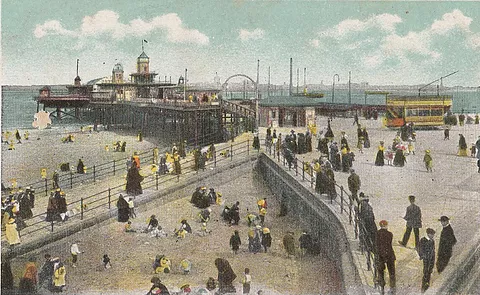
5/ New Brighton Pier Suicide, November 1874
One afternoon, a black glove was found on a pillar at the end of the pier at New Brighton. Inside was a note that read; “I committed suicide this morning at four o’clock. Mary Johnson, Manchester”. Was it a sick hoax or genuine? Well, it just so happened that on June 16th, 1873, the body of a Manchester man called W.J. Johnson, was found drowned near the pier.
6/ New Brighton, (Beach Suicide) August 1845
A man named Edwards, who was a partner of a Liverpool iron merchant, was found on the dunes at New Brighton. He was on the Cheshire side of the Mersey. A couple of pistols lay nearby, one of them had been fired, so it was suicide. The reason for him shooting himself was down to stocks and shares problems; he sold stock he didn’t have.
7/ Dale Street Skeleton, Liverpool, September 1862
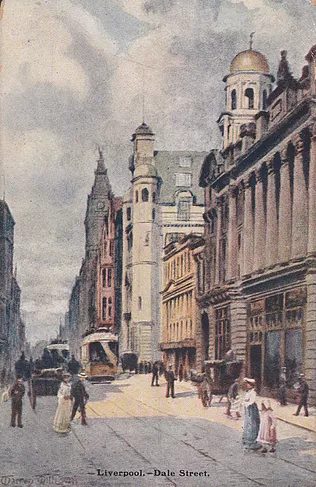
While some workmen were digging up a section of vacant ground on the south side of Dale Street, they struck something hard. Further investigation revealed a skeleton. The bones were on the site of Peter Street where there used to be a row of pubs and brothels, which were hang-outs of the criminal fraternity. It is believed that the skeleton was once a murder victim of one of these thugs.
8/ Lime Street Station, Liverpool, (Baby in a Box) February 1889
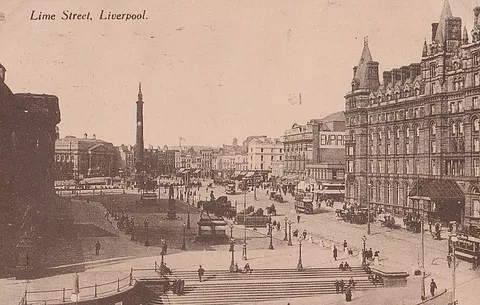
An amazing discovery was made in the parcel office at Lime Street Station. One of the clerk heard a noise coming from one of the boxes, opened it up and was greeted with the sight of a baby boy. He was in a box addressed to a “Mrs Cranworth, Liverpool. To be left at parcel office till called for.” The child was taken to the workhouse to be fed and changed after the doctor had examined him, and it was his opinion that to keep him quiet he had been drugged. He was originally from the Midlands area.
9/ Liverpool, (Baby on a Tram) May 1888
Another abandoned child story, this time the infant was discovered on a tramcar in Liverpool.The tram had just done its route and transported lots of passengers from the Pierhead to Wavertree and was back at the depot waiting to be cleaned. One of the cleaners was inside the tram when he found a brown paper parcel under a seat. There must have been an odour, because when they opened it, and lo and behold there was a baby girl wrapped in cotton cloth. (Was she alive?)
10/ Liverpool Docks Murder, May 1891
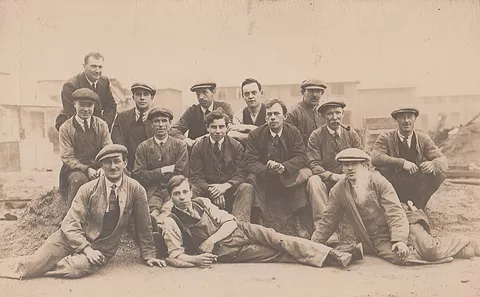
I found the above postcard in my collection, and all it said on the back was “Liverpool Dockers” so I’ve used it for this horrible story from the Docks. A gateman saw a bag floating in the water, which was rather large in size, so he hooked it in and opened it out of curiosity. Inside was a teenage boy with his throat slit and both legs had been amputated at the knee. Clearly, somebody had murdered the boy and tried to chop him up and then dump the remains in Sandon Dock. Police thought that he could have been dumped in the river and that it floated to the Dock. The description of the boy was; four feet three inches tall, brown hair, grey eyes, brown corduroy jacket, black trousers. He had sixpence in his pocket and two brass buttons. (You see how little life means in Victorian Britain?)
11/ Liverpool Triple Murder, August 1890. (The name is Leah Charlton aged 28)
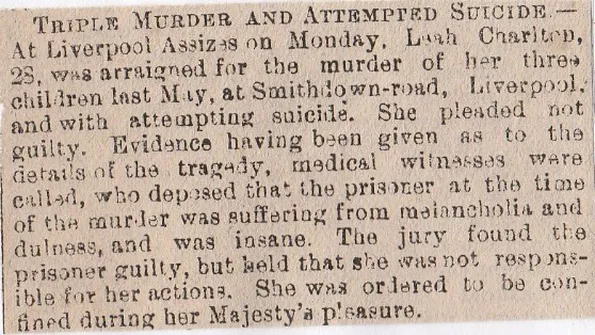
12/ Liverpool Tragedy, June 1891
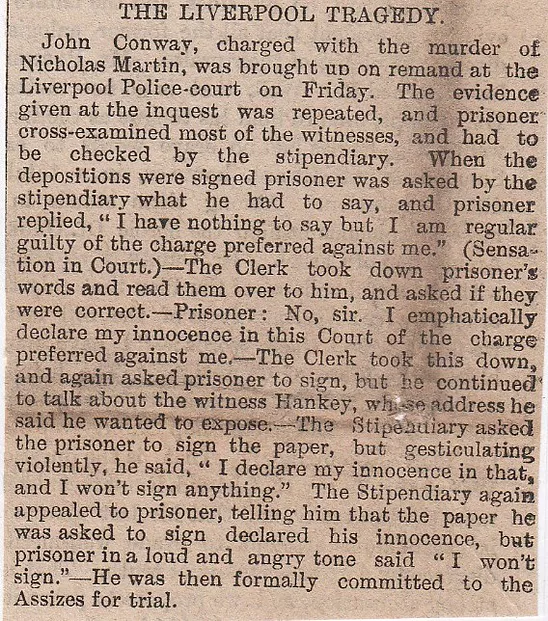
13/ Liverpool, (Music Hall Death) May 1900
John Walker aged sixteen was killed by a fatal fall at a Liverpool music-hall. He was jumping from tier to tier to try and get a seat at the front, but he fell headlong into the pit and was killed instantaneously. The fall was one of twenty-five feet and the coroner returned a verdict of “Accidental Death”. (Which Music-Hall?)
14/ Toxteth Park, (Concealment of Birth) August 1895
Eliza Thompson aged twenty-six was arrested in County Tyrone, on a charge of concealment of birth. Thompson ran a pub in Toxteth Park where the remains of a four-month-old child were found under the attic floorboards. The tenant who took over the building complained about the stench, she told him it was damp, when in fact it was the decomposing body of an infant.
15/ Toxteth Cemetery Suicide, September 1902
An unknown man committed suicide in Toxteth Cemetery in Liverpool by gulping down a dose of carbolic acid. (Who was this fella?)
16/ Woodchurch Wife Murder, near Birkenhead November 1885
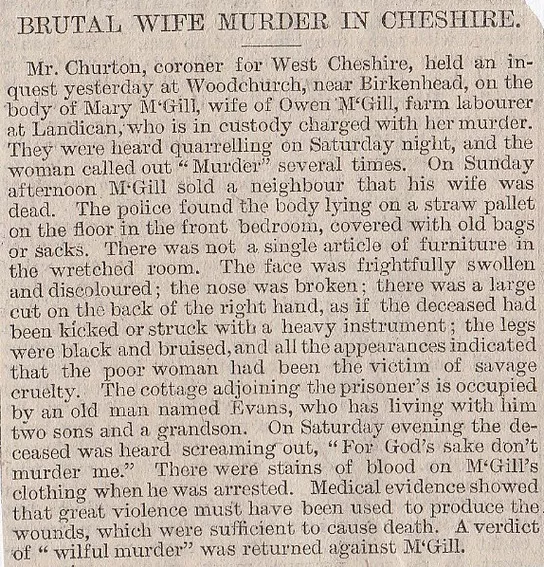
17/ Maghull, (Fireman’s Death) March 1899
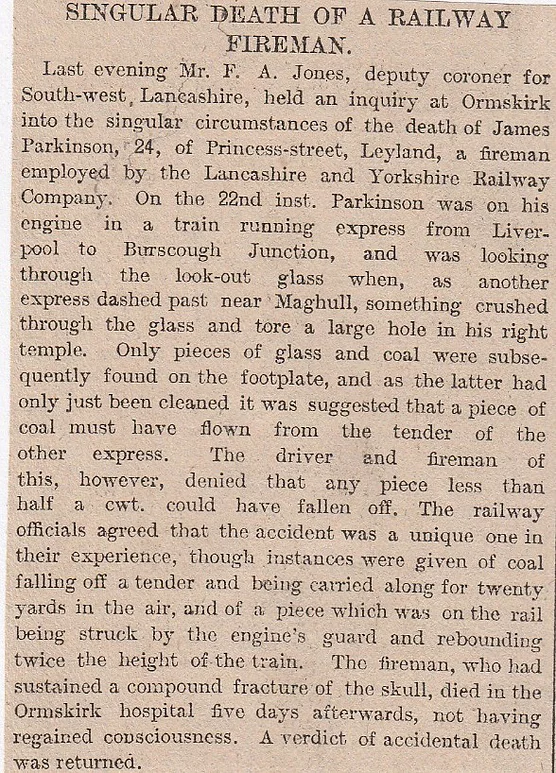
18/ St Paul’s Churchyard, Liverpool, (Body-Snatching) June 1894
During conversion work into an ornamental garden, at St Paul’s Churchyard in Liverpool, an empty coffin was found. It was meant to contain the corpse of a former rector of the parish, Reverend Henry Barton, who died around eighty years ago. It is surmised that body-snatchers of the time are responsible for the empty coffin.
19/ George Hotel, Liverpool, (Bride and Widow on Same Day) May 1859
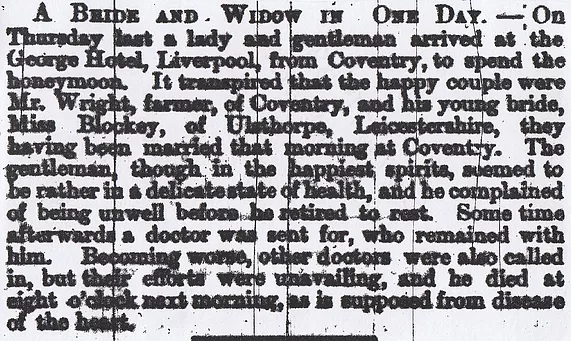
20/ Edge Hill Railway Death, September 1885
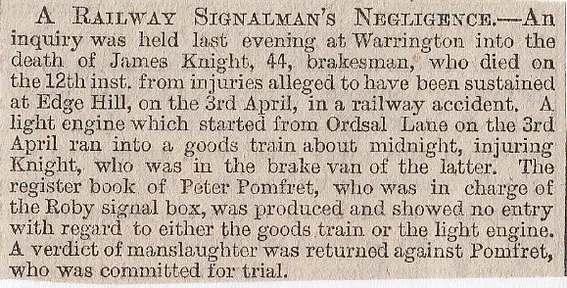
21/ Hoylake, (Skeleton Found) August 1868
At the end of August, a skeleton was discovered among the sand dunes of Hoylake. The bones were entire but had no flesh at all or of any clothing. Some nails were found near the body, the sort used on boots. P.C.Garside took possession of the skeleton and police are currently investigating.
22/ Lime Street Station Suicide, February 1875

On the 4th of February, the sound of gunfire echoed around Lime Street Station, Liverpool. An officer, on duty near the place the gunfire was heard, found a gentleman with a gunshot wound in his mouth. His hand had the revolver in it. He was on a train that was due to leave for St Helens at 11-20 and his death was immediate. He was in his early thirties, smartly dressed, with no rail ticket or money found on him, but he had several letters and cards on him, addressed to various places. There was also telegram addressed from the North Western Hotel to a place in Leeds. (Who was the guy?) Could have been German as well.
23/ Bebbington Station (Wirral), (Mutilated Corpse) October 1885
On the Great Western Railway near Bebbington Station yesterday morning, a platelayer on the way to work, found the body of a well-dressed, middle-aged man lying on the line near Trafalgar Bridge, who was terribly mutilated. The head and one leg were severed from the body.
24/ Liverpool, March 1854 (Sad Suicide Note)
This one relates to the suicide of 36-year-old Martha Gaudy, and the reason, as so often the case with Victorian women, was one of disappointment in love. At seven a.m. Sunday, her sister heard the sound of a gun, went to see what was going on and found Martha lying on the floor with a bullet wound to the head. On the table was the following note:
“My Dear Father- Forgive me for the rash act I am about to commit. I cannot live in misery. Adam (the lover) will not come when he promised us. He never performs it. Whenever I see him, he treats me with the greatest cruelty, and I have not had a happy hour for the last two or three years. Never Mind. Grieve not after me. I shall be happier in heaven than being in this world. All that I have to name is not to allow Ned (her brother) to follow me to the grave. The Almighty will reward him for his conduct to me. Adieu forever. Martha Gaudy”.
25/ Atlantic Ocean/Liverpool, (Murder at Sea) October 1884
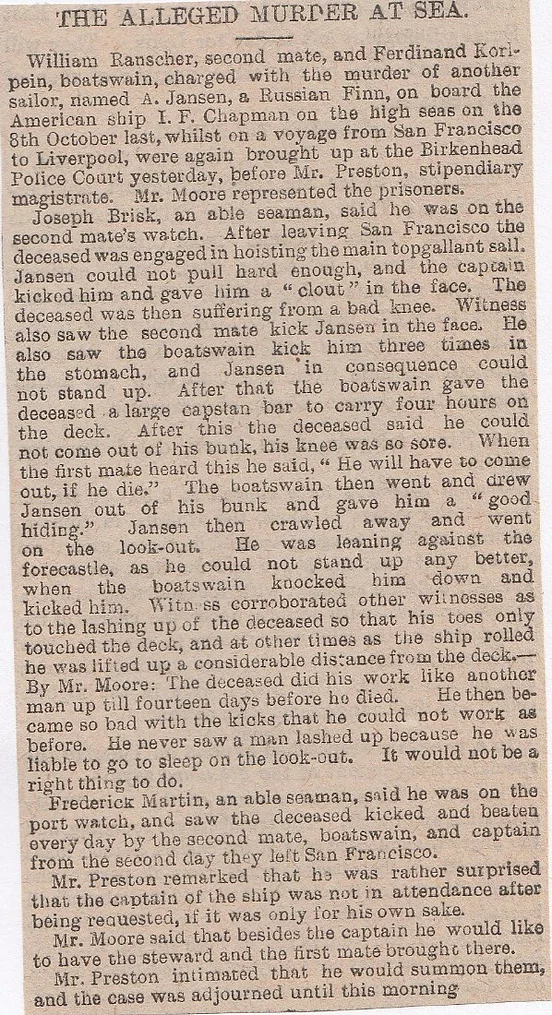
26/ Liscard Suicide, Wirral, December 1857
Mary Woods, a 66-year-old spinster, went missing from the bedroom of her house at Liscard. Some of the locals had reported seeing a white figure, somewhat ghostly in appearance, walking towards the ferry. In the morning her body was found floating in the river, wearing only a nightie. (Suicide or Somnambulism?)
27/ Peasley Cross, St Helens, (Horrific Train Fatality) June 1909
Lois Smart from Lunts Heath, Farnworth, was catching a train at seven o’clock on Saturday night at Peasley Cross when she was knocked down by an engine and sliced in two. Her brother, John Thomas Smart aged twenty-eight, who was there to see her off, was also struck and had both his legs cut off.
28/ Edge Hill Station, (Train Murder?) August 1899
As the train arrived at Edge Hill Station from Runcorn, a third class carriage was being checked by the ticket collector. In it lay the body of George William Cornwall of West Derby Road in Liverpool. His throat was cut from ear to ear and the head nearly severed from the neck, but there was no sign of a razor or other weapon in the carriage. Robbery can’t have been the motive, as his watch and money were still on him.
29/ River Alt/Formby, (Soldier Drowned) August 1889
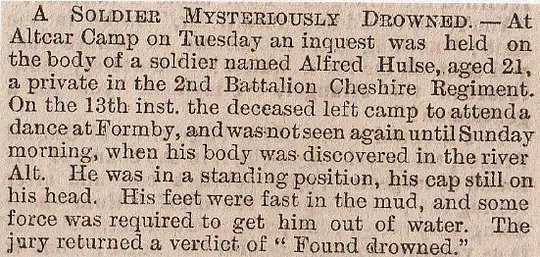
30/ St Helens, May 1885
At St Helen’s yesterday, a widower named Pearson was committed for trial charged with having attempted to poison his three young daughters by administering to each a small quantity of oxalic acid. The prisoner appears to have been impelled by abject poverty to desire the death of his children.
31/ Liverpool Stabbing, April 1889
A fireman named McEwan and a seaman named McTighe quarrelled in a street at Liverpool late on Sunday night. No notice was taken of them, but some time afterwards McTighe was found on the ground dead, with a terrible stab penetrating from the shoulder blade into the lung. Police are investigating the affair.
32/ St Helens, (Steeplejack Falls 200 Feet) August 1892

33/ St Domingo Pit, (Two Girls Found) Liverpool April 1880
J.Evans from Vienna Street found the bodies of two full-grown female children in St Domingo Pit. On each girl’s body was a cord fastened around the neck, to induce strangulation. They were both badly decomposed and wrapped in calico and a piece of blue dress material. Police are investigating a double infanticide.
34/ Tranmere, (Victorian Ofsted Cause Suicide) January 1879
The body of Miss Jane Kerr, a schoolmistress at St Mary’s Church of England School, Birkenhead, was found on a beach at Tranmere. Unusually she let the kids go off half an hour early and then left at half-past four. Apparently, she was very nervous about the Government Inspector of Schools doing his visit and this had caused the suicide. When she was found, her body was frozen solid.
35/ Great Howard St, Liverpool, ((Body in the Post) June 1874
The body of a newly-born male child was found in a box at Great Howard Street goods depot. It had been posted from Granton in Scotland and was addressed to an M.Kay in Liverpool, but they could not be found, so it was sent to the goods depot. It was opened due to the horrid stench coming from the box, then the contents were found to be a dead infant. It is thought that the child was born alive but died a couple of hours afterwards.
36/ Pocket Nook Junction, St Helens, (Wall Kills Man) February 1885
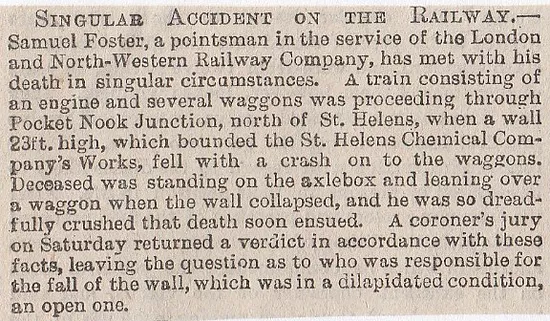
37/ Parr Drowning, near St Helens, January 1885
A sad accident occurred at Parr village near St Helen on Wednesday afternoon. James and John Simms aged eight and twelve years respectively, went on the ice of a deep pit to slide. James fell on his back and the ice broke. John lay down at the edge of the hole and clutched his brother. The ice again gave way and both were struggling together. An alarm was raised and John was rescued, but James was drowned.
38/ Oakfield Road, Liverpool, (Headless Child) December 1900
A servant girl was sent to remove a piece of sacking which had been placed in front of a clergyman’s house in Oakfield Road. The sack in the garden was found to contain human remains. Liverpool police examined them and they are of a child, with the head had been cut from the body. (Ever found the culprit?)
39/ Clock Pub Suicide, London Road, Liverpool, January 1879
Thirty-five-year-old John Livesey, who lived at 46, Creswick Street, committed suicide in the Clock public house (Mr.Modsley’s) on London Road in Liverpool. He entered the building and asked for a ginger beer, then he sat down and chatted to the barmaid about how he was meeting a friend there. Soon after, Mr Modsley went into the parlour and saw the chap with his head resting on a table. On raising his head, he seemed to be lifeless, and the doctor confirmed this later on. On his person were found a bottle of cyanide of potassium and a letter addressed to the editors of the Liverpool and Manchester newspapers, which said that he had been unemployed some time and was penniless. It also stated that he wished to say goodbye to his relatives, saying he was “Becoming desperate”.
40/ Birkenhead Suicide, June 1885
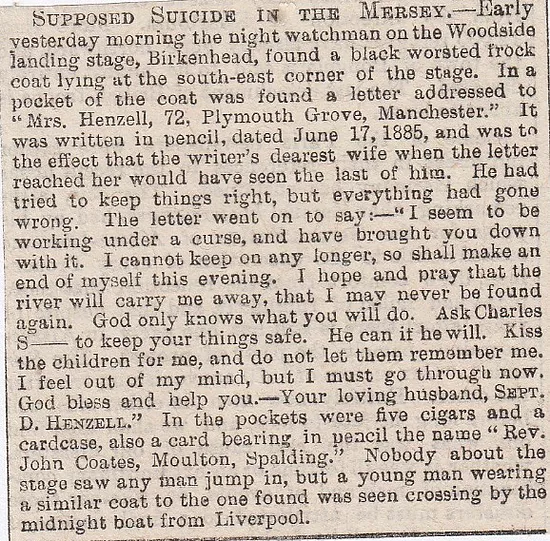
41/ Earlestown Drowning, July 1885
At Earlestown on Saturday afternoon, several lads were playing on the bank of the canal belonging to the London and North-Western Railway Co., near the Ship Inn, Newton Common, when one of them, named William Armstrong aged eight years, slipped into the water and was drowned.
42/ Richmond Row Murder, Liverpool, (Solved Four Years Later) August 1866
Around four years ago (1862), a murder was committed in Richmond Row in Liverpool, the victim being a Mrs Reed. The husband, a tin-plate worker was the main suspect but he had vanished from the area. Police in the United States arrested Reed a few weeks ago and it came to light that he murdered his wife four years ago. He had a successful little business, but he and the missus argued over the slightest things and he’d often threatened to “do” for his wife. His story was that he had come home one night and found his wife at a neighbour’s house. She came back after fifteen minutes or so, but the next time anyone saw her she had a fatal stab wound to her body. A Detective from Liverpool police went to New York to bring Redd back to justice.
43/ Sefton Park Suicide, March 1893
A man was found hanging to a beam of one of the bridges at Sefton Park in the city of Liverpool. He was bedraggled and frightfully skinny, so his answer was suicide. Crowds of people flocked to the park eager to catch a glimpse of the place where he committed suicide. He is unknown at the present time.
44/ Dinham Villa, Rainhill Murders, (Frederick Deeming) March 1892
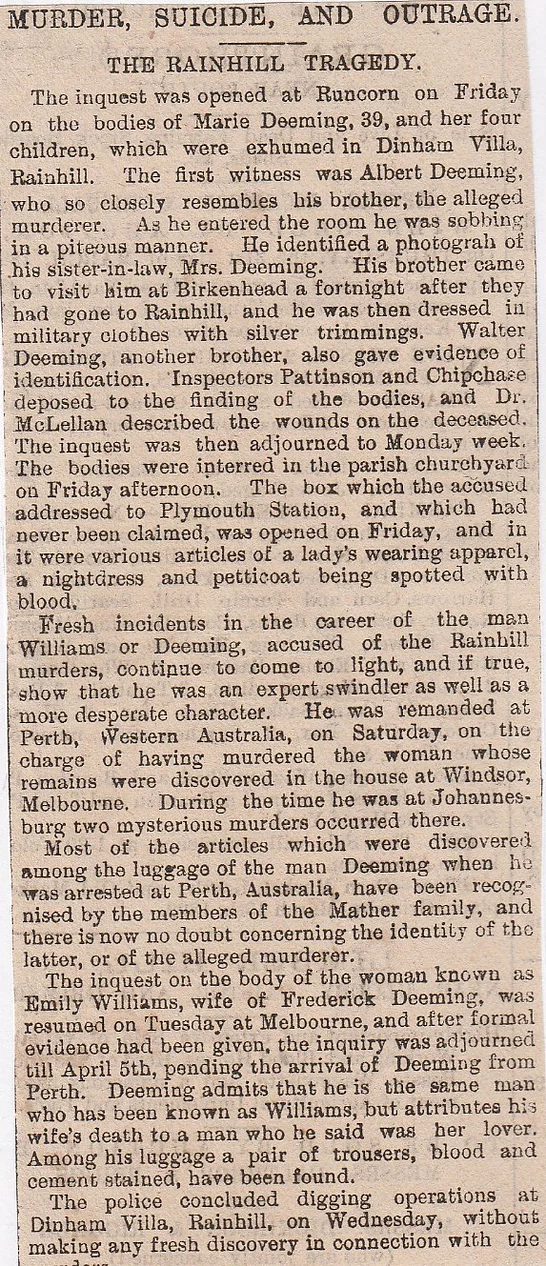
murders.
This one is infamous because it was thought that Frederick Bailey Deeming was a main suspect in the Jack the Ripper killings. He committed the Rainhill murders in July 1891 and was hanged in Australia, for another murder in May 1892.
45/ Liverpool, (Decomposing Child in a Box) February 1893
In December of 1892, a box was sent to Liverpool on the steamer Princess Alice, addressed to a Mrs Black. The usual scenario occurred when an awful smell came from the box, so it was opened. Inside was the body of a decomposed child, wrapped in a Glasgow Herald newspaper.
46/ Liverpool, September 1919 (Murder in a Dream)
Harry Theman of the U.S.steamer, Victorious, shot a young dock labourer named Samuel Emmett, opposite the gates of the Canada Dock. Emmett was at a news-stand when Theman came up and said ” You’re a crook. I have known you for some time”, then he took out a gun and shot the fellow. He was arrested and told police “It’s all right; I shot him”, then later stated, “I had a dream last night in which I saw my dead mother, grandmother and aunt. They told me that if I went into the streets and saw a desperate burglar, I was to shoot him. Then I would go to Heaven.”
47/ New Brighton Drownings, August 1885

48/ Bootle, (Parents Suicide) September 1855
In July 1855, a Mr Holdsworth accidentally drowned whilst swimming at New Brighton and he left behind a widow and five daughters, the eldest was fifteen and the youngest was three years old. Obviously, Mrs Holdsworth was in a state of shock and had been ever since, so as a precaution she went to live with her brother at 7, Lower Mersey View in Bootle. In the paper, it was described that she had an attack of paralysis, (could it be a stroke?), and she became house-bound almost. Mentally and physically she got weaker and weaker. One morning she was left alone for a few minutes giving her the chance to grab a razor and slit her throat. Now the children are orphans and have no provision made for them.
49/ Adelphi Hotel Suicide, Liverpool, November 1851
In mid-November, an American man named Barnes committed suicide at the Adelphi Hotel in Liverpool. The man was here on business, primarily to buy Sheffield steel. He was at the hotel when he became ill and a medical attendant was placed there to keep an eye on him. He somehow got hold a razor, then cut his throat. He was buried in the Liverpool necropolis and his stuff sent back to America. (What room?/ Is it still there?)
50/ Liverpool Exchange Newsroom Suicide, February 1856
A young man named W.Tatham, cut his throat at the Liverpool Exchange newsrooms and died later on at the hospital as a result of his self-inflicted injuries. He was, apparently, under some pressure both financially and business-wise.
51/ St Helens Junction Suicide, August 1885

52/ Albert Pierhead Suicide, August 1893
A smartly dressed man in his mid-thirties shot himself in the head with a revolver at Albert Pierhead, Liverpool. There was no identity on him but he has the look of a foreigner and there was a silver watch, some money, a gold chain and a key on his person. He had a sallow complexion and had a moustache.
53/ Childwall Suicide, May 1852
The parish church clerk of Childwall hung himself in the hearse-house, which adjoins the churchyard, with the rope that is used for lowering the coffins into the ground.
54/ Ashton Street, Liverpool, (Child Remains Found) May 1881
The decomposed body of a child was found in an entry off Ashton Street, Pembroke Place. It was wrapped in a piece of calico and was described as more of a “ball of soot than human remains”. The child’s arms and legs were doubled up, as it was obviously forced into the chimney and it was covered in soot. It had started to smell and then the murderer had taken the body from the chimney and thrown it near to where it was discovered.
55/ River Mersey Drownings, June 22nd, 1885

River Mersey, June 24th, 1885
An inquest was held on the bodies of Mr John C. Green and Mr William Clayton, who lost their lives on Saturday evening through the capsizing of their boat, the Bessie, during a race on the river. The evidence of Mr.William Taylor, the only survivor of the crew of the boat, was to the effect that the boat was struck by a sudden squall and went down before the sheets could be loosed. The verdict, unsurprisingly, was “Accidentally Drowned.”
56/ Southport Fire, November 1885
About eight o’clock yesterday morning, two men passing along Seabank Road in Southport, discovered that a house was on fire. They knocked and got no answer and then entered by a window in the front bedroom. The bed was on fire and on it was a woman fully dressed. They got the woman out of the room but found that she was dead. The deceased was Sarah Elizabeth Heywood aged about fifty. It is supposed that a light by which she was reading had set fire to the bed.
57/ Newton-le-Willows Boiler Explosion Deaths, October 1885
At six o’clock last evening, the inhabitants of Newton-le-Willows were greatly alarmed by a massive explosion at the papermaking works owned by Messrs.Gillespie and Co. Upon examination it was found that a large boiler which worked in the yard had burst with terrific force. Two of the workmen were killed instantly and other men were less seriously injured.
58/ Bootle Murder, September 21st, 1885
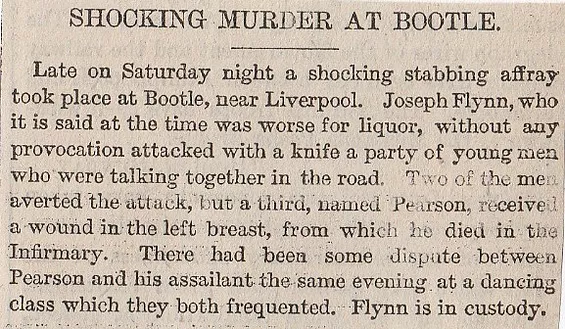
Bootle Murder, September 23rd, 1885
For mortally stabbing Edwin Pearson at Bootle on Saturday night, Joseph Flynn aged eighteen, was yesterday committed for trial for wilful murder. The prisoner, in reply to the usual question, declared that he was mad with drink and did not know what he was doing.
Bootle Murder, November 27th, 1885
Two prisoners condemned to death at the Liverpool Assizes- Joseph Flynn, for stabbing a man at Bootle in a street affray and William Boyd for stabbing a man named Kellett at Blackburn, in a public-house affray-have had their sentences respited by the Home Secretary.
59/ Ashton’s Green Colliery, St Helens, (330 Feet Fall) December 1885
At noon yesterday, John Sutch, labourer, forty-three-years of age, who was employed in the sinking of some new coalpits at Ashton’s Green Colliery, fell out of the hoppet down a shaft, 330 feet deep and was instantly killed. The body was shockingly mutilated.
60/ Mersey Mills, (Two Lovers Drowned) December 1885
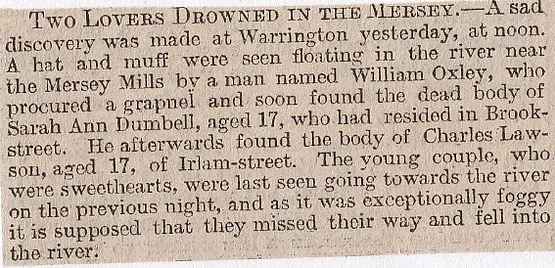
61/ Temperance Hotel Suicide, Manchester St., Liverpool September 1885
Lucy Ardron was employed at the Temperance Hotel and she killed herself by drinking carbolic acid. It’s quite a sad story actually because she met a young bloke from Edinburgh three weeks previously and they struck it off immediately. He left for Manchester about a week since and she began to fret when she only got one letter from him. Lucy told a member of staff at the hotel that she wanted to die. That same night she found Lucy slumped over, with the carbolic acid next to her. She died later on in the hospital and the verdict was “Suicide whilst suffering from temporary mental derangement.”
62/ High Park Road Suicide, Liverpool, June 1857
An awful suicide took place at Mr Aspinall’s druggist shop, High Park Road in Liverpool. The victim was William Fanaker Lee, twenty-one-years-old and the assistant to Mr Aspinall. He was at work one day and seemed to be drunk and behaving erratically, when he tied a rope around the door handle, then bringing it over the top of the door formed a noose, then hung himself. A servant in the house told of his cursing all the time. The jury’s verdict was “Temporary Insanity”.
63/ Coliseum Theatre Tragedy, Liverpool, October 1878

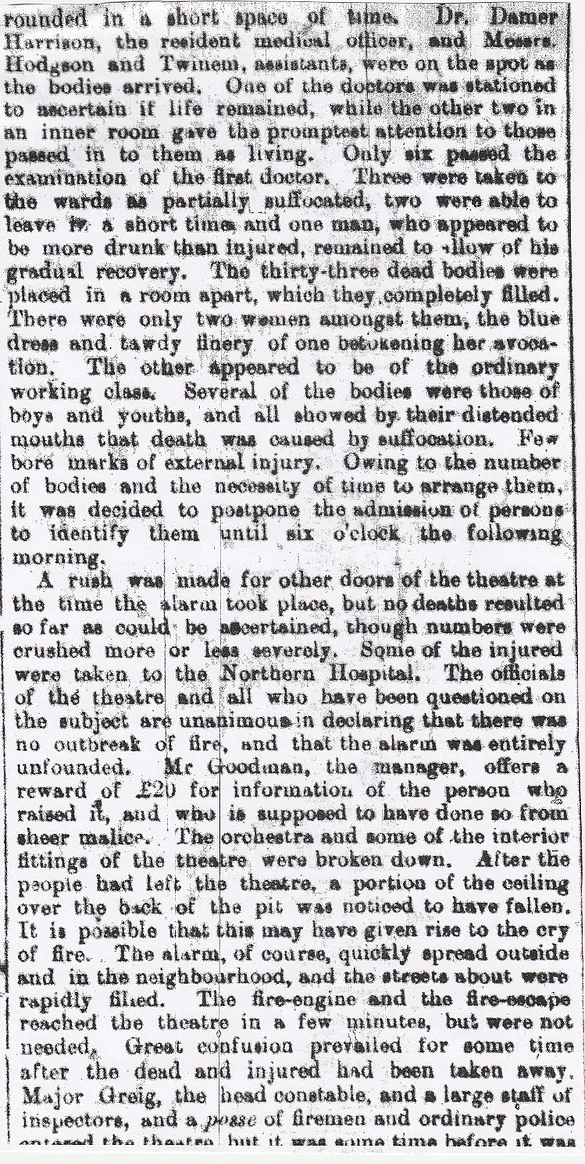
cleared, the people remaining out of curiosity after the panic had subsided. Major Greig seized the opportunity of exhorting them to calmness when similar alarms might be raised in future.
64/ Birkenhead Post Office Murder, September 1900
An elderly night watchman named Fell was murdered at Birkenhead Post Office and the safe was robbed of £150. The clerks coming in to work on Sunday evening found blood spatters all over the place and a search revealed Fell in the postmaster’s office, with his head bashed in with a poker. The sheer force of the blows broke the poker in two.
65/ Huskisson Dock, Liverpool, ( Sewer Deaths) August 1857
A fatal accident occurred which took the lives of two men. John Kelly aged thirty-five and Dennis Mulloy aged thirty-five as well, both labourers for the Dock Trust, had gone down a sewer to clean a privy which was blocked when they became overpowered by the gas and passed out. They were brought out and taken to a shed and put in a hot bath, but they were already dead.
66/ Upper Pownall Street, Liverpool, (Warehouse Fatality) February 1909
Thirty-six-year-old John Francis Cruse, a porter, was tragically killed at the rice mills of Messrs Heap and Sons in Upper Pownall Street. He was on a lorry when his apron string got tangled in a rope which sacks of rice were being hauled up to the warehouse. He was taken about thirty feet up, then he fell through an open basement, smashing his head on the floor.
67/ Southport, (Death by Corn in Ear) September 1885
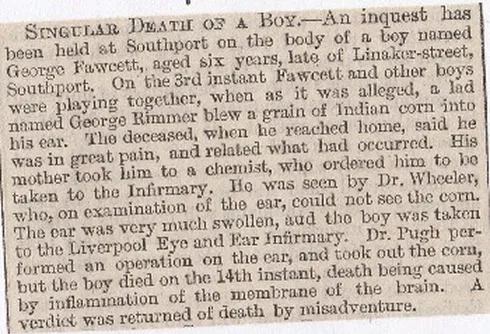
68/ Hope Place, Liverpool, (Body in Empty House) July 1884
A shocking discovery was made at an empty house, No.22, Hope Place, Liverpool. It had been empty for a year and two water board employees, Robert Bell and William Morgan, went to check the place, when they found the decomposed corpse of a woman. The police took the body to the morgue and it was nearly mummified. The hands had a currant loaf and a tea flask grasped in them. Laying around was a newspaper from July 1883. It is supposed that the lady poisoned herself in the building.
69/ Boys Refuge, St Anne Street, Liverpool, (Boy in Boiler) March 1881
An inquest on the body of Charles Boyle, nine years old, who was an inmate at the Boys’Refuge in St Anne Street, revealed that while playing in the wash-house he fell into the boiler, about five feet deep. A lad named Lewis said that he was going to get some water to wash his neck when he saw the face staring up at him. The poor chap was literally boiled to death and a recommendation to the Refuge that the wash-house must now be off-limits to inmates.
70/ Southport, (Accidental Shooting) December 1885
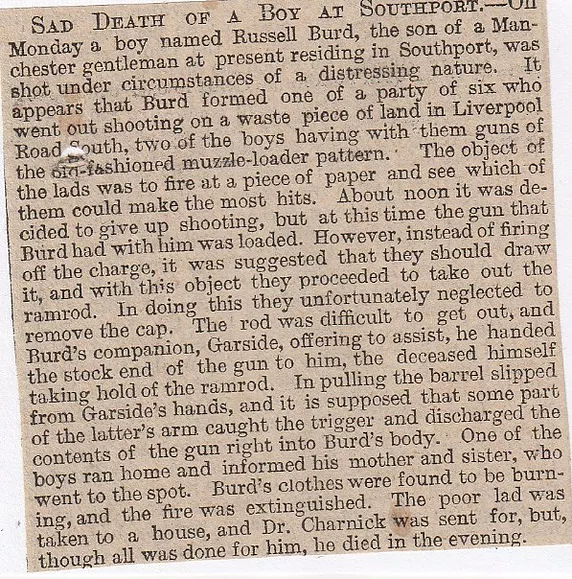
71/ Bachelor Street, Liverpool, (Horrific Accident) April 1859
John Jones, a worker at the McFies sugar refinery in Bachelor Street, was killed when he got entangled in the machinery. His legs were torn off below the knees and his ribs and shoulders were crushed. He leaves a wife and family with no provision for their care.
72/ Brownlow Hill Shop Suicide, June 1872
This is a strange suicide! Mr Cross, a leather salesman in Brownlow Hill, went downstairs into the basement to get an item for a customer. When ten minutes had passed and no sign of Cross was apparent, the customer went down to the cellar and found him hanging from a beam.
73/ Maghull Station Fatalities, January 1850
At Maghull Station on the East Lancashire Railway, a train came in with only one carriage. There were far too many passengers in one carriage, so they decided to add another. They moved it to another track and while it was going forwards another was seen to be heading for it. Passengers saw the potential disaster and leaped out, but three were run over and instantly killed.
74/ Liverpool Tram Death, April 1899
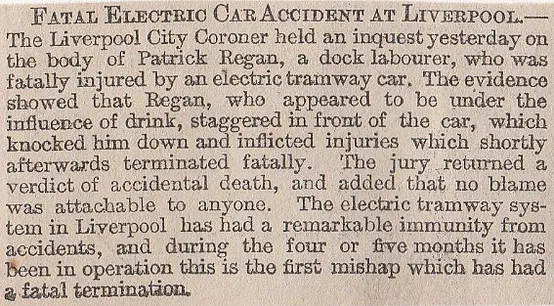
75/ Lambeth Street, Liverpool, (Suicide Letter) May 1863
Thomas Slack, a plasterer, hung himself in Lambeth Street. He put a brush handle over the trap-door and hung from that. He recently had a conviction for assault and this preyed upon his mind, as his letter states: “Dear Wife- I am leaving this world forever. I leave my two children in care of Dr Taylor, St Silas Church, Pembroke Place, Liverpool. Drink and poppery and trade Society as brought ruin upon me. Thos.Slack. I am some ware about 30 years. I can hardly muster the strength to do what I am going to do. God bless my children. Thay are laying a trap for me every ware. Holy Virgin pray for me.”
76/ Liverpool Sister Murder, March 1899 (see No. 105 )
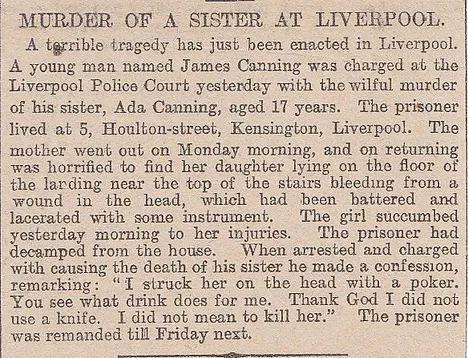
77/ Rock Ferry (Wirral), (Fatal Fall from Rigging) June 1857
Fifteen-year-old Thomas Lang died when he fell from the rigging of the Akbar Reformatory Frigate, which was lying off Rock Ferry. He was buried in Rock Ferry Cemetery, with his shipmates, ninety in all, dressed in white suits. They all had a whip-round for his parents and managed to raise £2, and gave it to them next to his grave. He was a tearaway but the stint on board the frigate had changed his character totally.
78/ Liverpool Wife Murder, July 1889
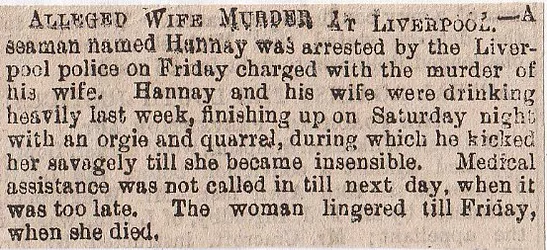
79/ Stanley Arms Suicide, Manchester Street, Liverpool, March 1861
A man named George Arrow killed himself in the Stanley Arms in Manchester Street in Liverpool. He was about mid-thirties, was a jockey and was from Malton in North Yorkshire. He was in Liverpool under the impression that he was to race here. That never happened and he’d been several times to the Stanley Arms. One night he stood at the bar with a drink, got a glass then filled it with water, then put some powder in it and swallowed the lot. He started to convulse and wretch almost immediately and within ten minutes he was dead.
80/ New Brighton, (Shooting Gallery Death) July 1889
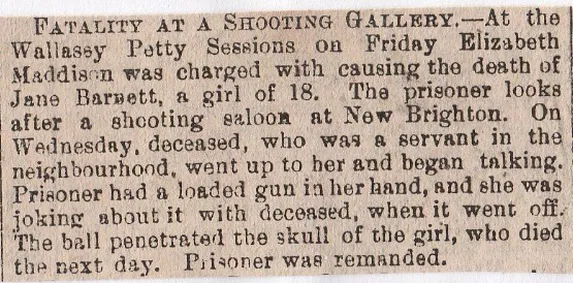
81/ Bee Hotel Suicide, Liverpool, March 1899
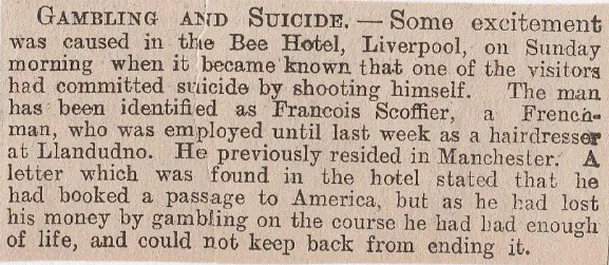
82/ Hesketh Park, Southport, (Playground Fatality) October 1900
A boy named Fernihough, about eleven, was found hanging to the parallel bars in a playground at Preston Road, Hesketh Park in Southport. The doctor was called, but he was pronounced dead at the scene and this is thought to be a dreadful accident.
83/ Bidston Hill, Birkenhead, (Corpse in Bushes) May 1893
The skeleton of a man was found in rhododendron bushes at Bidston Hill, Birkenhead. The garden is that of a racehorse owner, Mr R.C.Vyner and it was just covered over in leaves. The garden is used by the public, primarily for picnics, but the corpse had been there for many a year. The clothing and the bones crumbled when moved. (Who was it?)
84/ Everton Fatal Fight, February 1892

85/ Liverpool Free Library Suicide, September 1874
Thomas Raymond Fitzgibbon, thirty-years-old, was lodging at Morrell’s dining rooms on Lime St in Liverpool, when on the 17th of September he went to a reading-room at the Free Library. A person there thought he looked ill and told a keeper that someone was having a fit. He was taken to hospital where he died shortly after being admitted. Police searched his clothing and a few letters were among the belongings, all had the initials “T.R.” or Thomas Raymond. They also found a piece of paper with powder in it, bearing the word “Poison”. Further questioning at the Y.M.C.A.turned up that he was English but just got back from America and that he was depressed due to his unemployment situation. Poisoning by morphia was the surgeon’s diagnosis.
86/ Liverpool Child Murder, August 1892
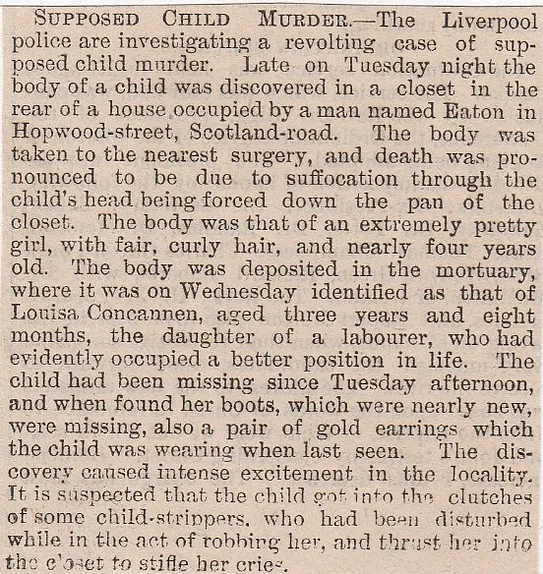
87/ Mossley Hill near Liverpool, (Corpse Under Bridge) February 1899
The dead body of a man who was terribly mutilated was found yesterday morning, underneath a bridge on the London and North -Western Railway at Mossley Hill. The body is believed to be that of a retired seafaring man aged about sixty, though there was no identification. The supposition is that the man threw himself or fell from the bridge and his neck was broken, in addition to injuries caused by a train going over him.
88/ Liverpool Lamp Murder, May 12th, 1899
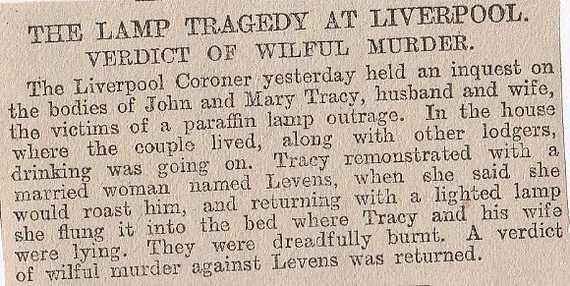
89/ Liverpool May 20th, 1899 (See Above)
At Liverpool yesterday, Catherine Levens, a married woman was committed for trial on a charge of the murder of John Tracey and his wife, by throwing a lighted lamp at them while in bed, by which they were burned to death.
90/ Rectory Street, Liverpool, February 1899
At Liverpool yesterday, Catherine Redmond, a middle-aged woman residing in Rectory Street off Wellington Road, was remanded on a charge of killing her husband. The evidence showed that during a quarrel she struck him on the head with a poker, inflicting a fatal wound.
91/ Mill Street Fire Fatalities, Toxteth, February 1899
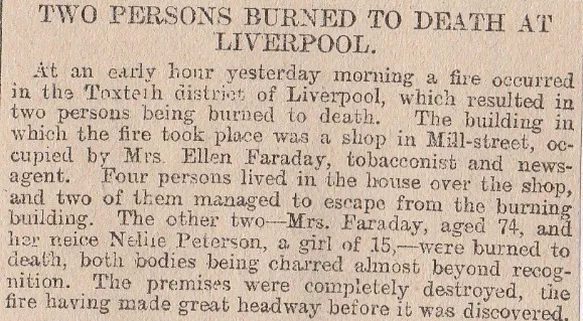
92/ Liverpool, May 1869 (Three Children’s Bodies Dumped)
P.C. No 346 found the bodies of two little girls dumped in a box of wood-shavings in an entry at the back of Gregson Street. About half an hour later, another P.C. found the body of a newly-born male, lying in a cart at Caryl Street in Toxteth Park. The boy was wrapped in an old piece of rag.
93/ Blowick Station Fatality, near Southport, May 1899
On Saturday morning, a little girl aged five years, named Bessie Thomas, travelling with her parents by a Bolton excursion train to Southport, fell out of the train when nearing Blowick Station. The train was stopped, but when the body was picked up, life was extinct. The girl’s neck was broken.
94/ Stanley Dock Bridge Death, June 1899

95/ Clippsley Row, Haydock, May 1899
On Saturday morning a fatal accident occurred at Haydock. The victim was a child named Mary Ann Burnet, the daughter of Earle Burnet of Clippsley Row in Haydock. The child was playing in the gutter and as a steam tram engine was proceeding along Clippsley Row, the child ran into the roadway and was caught by the engine and run over and cut to pieces.
96/ New Brighton, (Body on Beach) May 1899
The discovery of the body of a man which had been deposited by the tide on the beach at New Brighton has caused quite a stir. The body had been in the water a considerable time and a mysterious feature, in this case, was that a rope was tied around the body. Police are searching for clues as to the identity of the man.
97/ Bootle Murder, November 1902
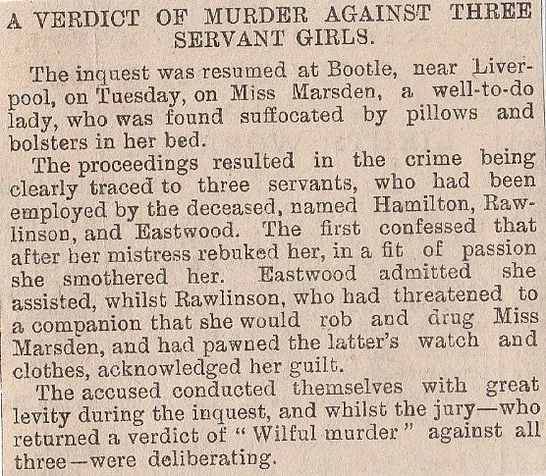
98/ Liverpool Child Murder, January 1901
Eveline Christofferson, six years old, was brutally murdered in Liverpool. She was found in an ash-pit of a tenement building in Parr Street, found with her throat cut from ear to ear. A lodger from the house has gone missing and he now remains the main suspect police are looking for.
99/ Liverpool Child Murder (see above) January 23rd, 1901
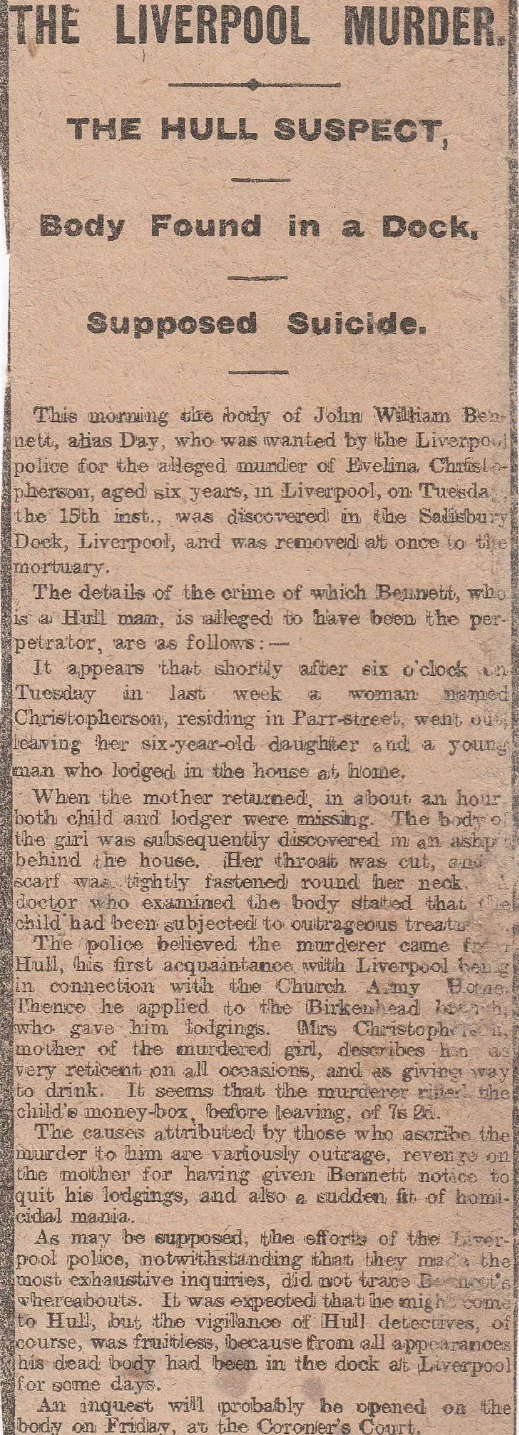
100/ Southport, (Buried Child Alive) August 1850
Ann Ball has been committed for trial on a charge of wilful murder of her infant. She buried the child alive in the sand on the sea-shore at Southport.
101/ Southport, (Boys Body in Attic) August 1888
The body of a young boy was found in an attic of a house at High Park in Southport. The boy’s name was William Tillyer Rhodes aged nine, from Manchester, who had been missing for nearly two weeks. He was visiting the area with his parent’s in Manchester Road in Southport and went with some other kids to Hesketh Park on the 1st August, where they went on the swings together. He stayed behind and was not seen again.
102/ Lewis’s, Ranelagh Street, Liverpool, (Lift Death) March 1895
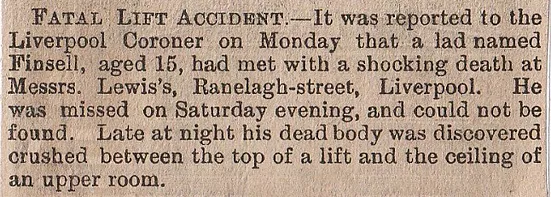
103/ Mount Cemetery Suicide, Liverpool, August 1835
A traveller by the name of Mercer, who worked for Arrowsmith and Ryder, liquor merchants of Manchester, killed himself at Mount Cemetery. He wrote a letter to his friend saying that he was going to the cemetery to carry out his own self-destruction. When he got there, he took off his coat, waistcoat and neckerchief, hung them on a bush, then went into the shrubbery and slit his throat with a razor. He leaves a widow and four kids.
104/ Liverpool Police Court (Acid Suicide) October 1897
A sensational incident occurred on Thursday morning in a Liverpool Police Court. A medical man named Johnson aged seventy, formerly one of the best-known practitioners in the city, was summoned by his wife for arrears under a maintenance order. After being sentenced to two months in prison, he drank a quantity of carbolic acid and died almost immediately.
105/ Liverpool Sister Murder, March 4th, 1899 (See No.76)
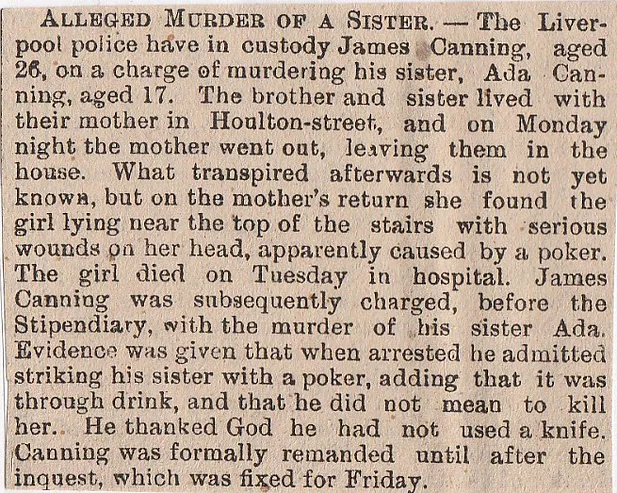
106/ Liverpool Murder, July 1895
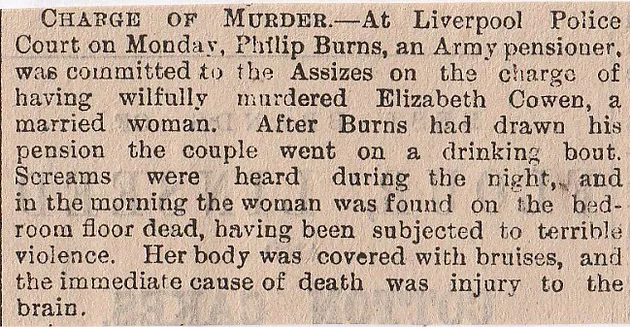
107/ Knowsley Hall Suicide, February 1868
Now more famous for the giant safari park that surrounds the Hall, this piece of gorgeous architecture holds a secret from the 1860’s. A servant of Lord Derby’s, named Hignith, was engaged to one of the other servant’s at the Hall and they were to be married very soon. With a few weeks to go to the wedding, Hignith suddenly thought that his bride-to-be was seeing another behind his back. Instead of confronting her about it, he went and slit his throat in his room. Temporary Insanity was the jury’s verdict. (Ask them which room it was next time you’re there!)
108/ Liverpool, January 3rd, 1885 (Norwegian Sailor Murder)
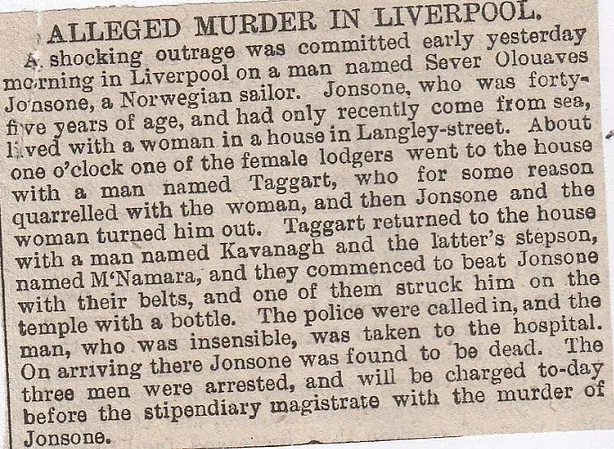
Norwegian Sailor Murder, January 7th, 1885
A coroner’s jury yesterday returned a verdict of wilful murder against Arthur Kavanagh, James McNamara and John Taggart, who attacked a Norwegian sailor and beat him to death in a low part of Liverpool on New Year’s Day night.
Norwegian Sailor Murder, January 17th, 1885

On February 11th they were found guilty of manslaughter and each got twenty-one months imprisonment.
109/ Oakes Street, Liverpool, (Dead Wife Falls on Hubby) August 1903
The daughter of William Shortis dropped in to see her parent’s at Oakes Street, but couldn’t get an answer, so she got a copper to break in. The policeman found William Shortis at the bottom of the stairs in an exhausted condition, beneath the decomposing corpse of his wife. It is thought that they were both going up to bed and she fell down the stairs on top of her husband. Her neck was broken and she was dead. Being extremely elderly, Shortis couldn’t lift his missus off him and stayed there for nearly a whole day. He died soon after at the Liverpool Workhouse and you have to bear in mind as well, that his wife was a hefty seventeen stone.
110/ Watkinson Street, Liverpool, (Wife Murder) February 1885
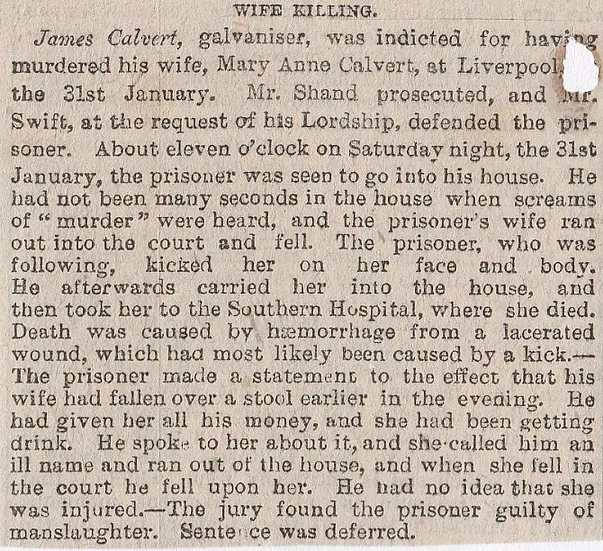
Watkinson Street, Liverpool, February 14th, 1885 (Sentencing)
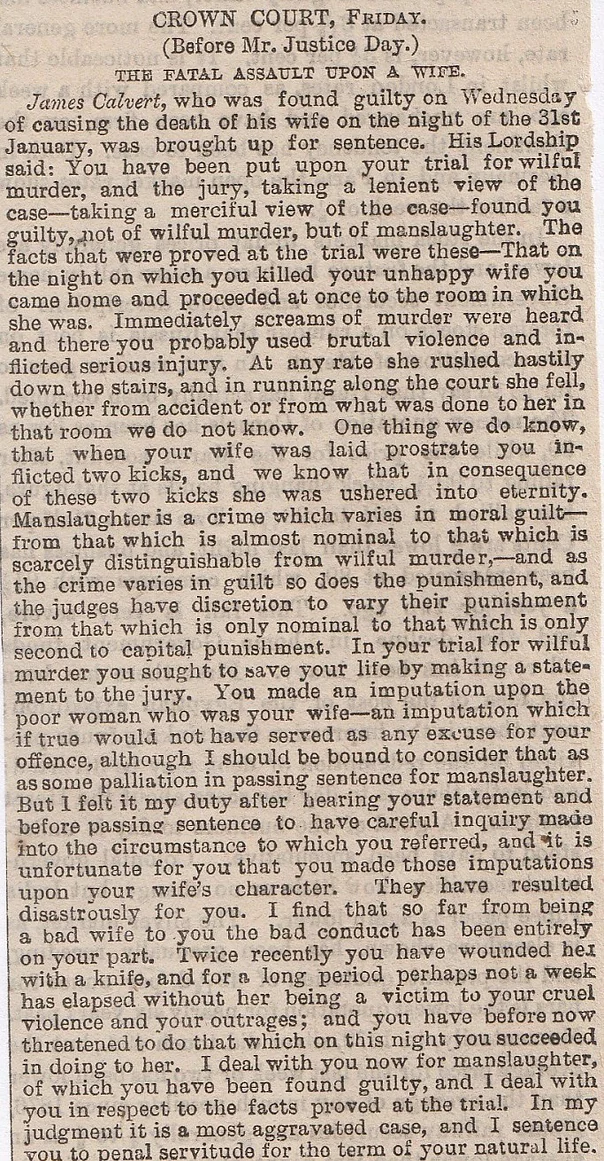
111/ Imperial Hotel Fire, Lime St, Liverpool, June 1916
A disastrous fire occurred at the Imperial Hotel on Lime Street. The fire broke out in a lift shaft, early on Sunday morning and then spread throughout the building with amazing speed. There were three deaths as a result of the inferno, they are; Annie Quinn, a cook at the Hotel, who burned to death in her bedroom; Jennie Parkinson, housemaid, was killed by leaping from a window on the fifth floor to escape the flames. Then there was a visitor from Dublin, William McClive, who also was killed from jumping from a window.
112/ Greyrock Street, Liverpool, (Coal Cellar Death) March 1894
A man was walking down Greyrock Street when he thought he’d come across a bundle of old clothes on the footpath. On closer inspection, it was a woman stuck in a coal-chute of a house. Police arrived and determined it was a woman named Margaret Ball, who was the housekeeper at the house. She turned up drunk one night and was turfed out of the house and she went away. Ball returned later on and tried to make a sneaky entrance back in, through the coal cellar and there she got wedged in and died from exhaustion.
113/ Kirkdale Cemetery Suicide, (Near Aintree Racecourse) May 1885
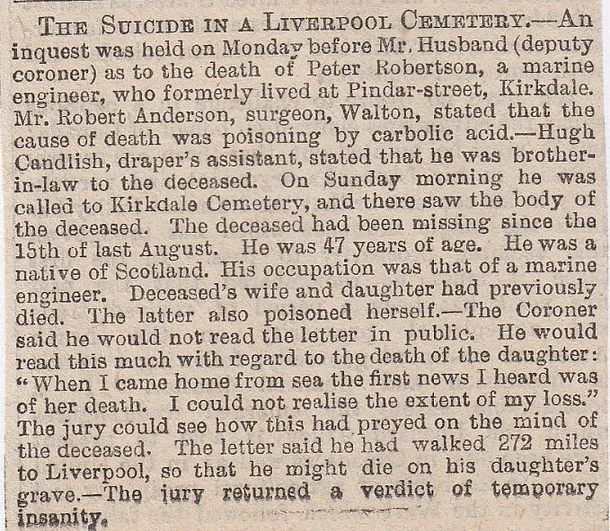
114/ Edge Hill Station Fatality, May 1885
On Saturday evening a ticket collector whilst collecting tickets on the London and North Western Railway at Edge Hill Station, slipped from the footboard and falling on the rails, was run over and killed.
115/ Preston’s Distillery Fatality, Liverpool, April 1885
At Preston’s Distillery in Liverpool yesterday, the body of a man unknown and evidently a labourer, was found in a vat of boiling liquor.He had, in getting into the premises, stumbled into a vat and been scalded to death.
116/ Sandhills Fatal Fire, Liverpool, March 1885

117/ Liverpool, (Concealment/Child Murder?) January 1877
This is a strange case, almost as though she wanted to be caught! Elizabeth Kirkbride, a widow, was charged with concealment of birth of three children. She worked as a school mistress in Penrith, Cumbria, and has been a widow since 1865. She went away from Penrith in June 1876 and left a box at a local inn, saying she’d be back for it. About a week ago the box was opened and inside were the bodies of two kids, one had its throat cut. Kirkbride’s room at Tuebrook was searched and another three dead children were discovered. One was decapitated, while another had a piece of cloth tied around its neck. When questioned she said that they were her kids but she never killed any of them. One of the bodies had been there about ten years, another about five years.
118/ Lower Bank Road Murder, Liverpool, June 1885
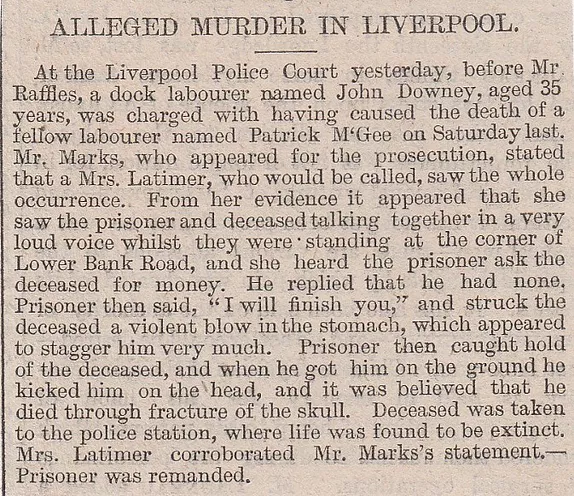
119/ Eccleston Hall Suicide, near St Helens, February 1869
A young lady by the name of Elizabeth Nevitt was walking up the avenue leading from Eccleston Hall. when she spotted a young man, later identified as Lyttle, a native of Northern Ireland, standing on a path among the trees. He stared at her as she walked past, she became frightened and sped up her walking pace. He was leaning against a tree and holding a gun in his hand. On passing him she heard a gunshot and spun around to see what happened and saw him drop to the ground, dead. It turns out that Lyttle was employed at a glassmaker and was a warehouseman there. They had to get rid of one of the staff and told him he could be demoted to his old job, or would have to leave altogether. This preyed on his mind, but no one there thought he would commit suicide. (Is the Hall now a group of flats?)
120/ Waggon and Horses Suicide, Liverpool, July 1885

121/ Bootle Quarry Suicide, April 1884
Two boys were walking along the footpath that goes from Breeze Hill to Hawthorne Road and looked onto the quarry that is nearby when they observed the body of a man lying at the bottom. The body was that of a local policeman, Wilhelm van Schaick, and it was dreadfully mutilated. At eight o’clock on Sunday morning, he signed off after being on the graveyard shift at Derby Road police station. It seems from here he went to the quarry and climbed a five-foot-high railing then jumped off the edge of the quarry onto rocks below, a height of over a hundred feet. He seemed to be suffering from insomnia and this had turned him cranky. He was liked by fellow officers and leaves a wife and two children.
122/ Church Street Tram Death, Liverpool, May 1885
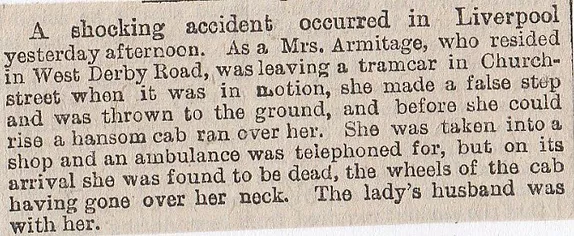
123/ Liverpool Murder, November 1885 (See Execution No 136, below)
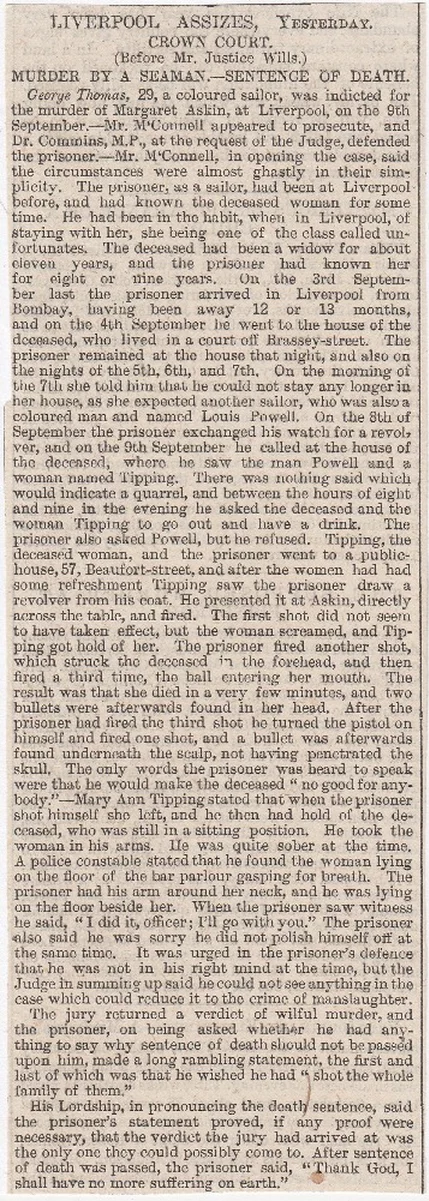
124/ Bootle Murder, November 1885

125/ Liverpool Zoological Gardens, June 1848 (Killed by an Elephant)
A man and woman were watching an elephant do his tricks, when he suddenly decided not to perform, so the keeper gave him a slap with a birch twig. He picked up the keeper in his trunk, threw him down and trod on him, causing his instant death. The animal was then to be put down with prussic acid, but this didn’t take effect, so he was shot by Her Majesty’s Riflemen. The owner paid 800 guineas for the beast, which was said to be the largest elephant in Europe.
126/ Liverpool Zoological Gardens, December 1843 (Killed By Elephant)
This story seems strangely familiar, in fact, it is almost identical to the above story. The man keeping the elephant, Henry Andrews, aged thirty-eight, was not the usual keeper of the animal. His dead body was found in the pen he was kept in and he had all of his ribs were broken, with a huge elephant footprint on his back and bruising on his head. He had only been in there for fifteen minutes or so and was cleaning the elephant, when, it is supposed, he struck it and the beast retaliated. “Accidental Death.”
127/ Liverpool, (Two Kids Suffocated) August 1885
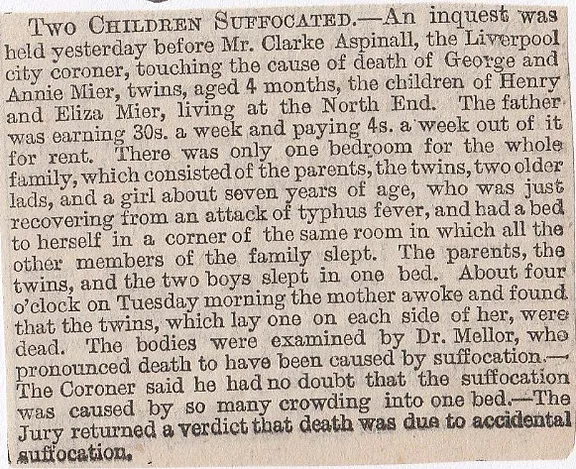
128/ Tue Brook Lunatic Asylum, (Ex-Vicar Suicide) October 1874
The Reverend William Henry Strong was an inmate at Tue Brook Asylum and had been there for about three weeks. For an ex-vicar, he was very violent and he had to have an attendant to keep watch on him. At dinner, the son of the asylum owner asked James Dent, the attendant, to cut up his meat for him as he wasn’t allowed sharp objects. This was done, but he never remembered this, because the next day he gave him breakfast with a knife and fork next to it. Strong was left alone for a few moments and when he came back, the Reverend had cut his throat from ear to ear.
129/ Liverpool Docks Deaths, August 1885

130/ Garston, Liverpool, December 1885
The magistrates at Garston, yesterday committed for trial a dock labourer named Duffey on a charge of wilfully murdering a man named Wainwright. He was attacked on the night of the election by a party with whom Duffey is alleged to have been concerned and he sustained injuries which proved fatal.
131/ Liverpool, (Dad Dies When Hears of Daughter Stealing) September 1885
At the Liverpool Police Court yesterday, a girl of fifteen named Morton, was charged with stealing a shawl and umbrella from Lime Street Station, also with stealing money from ladies in the waiting-room at Tithebarn Street Station. She was committed for trial. When Morton’s father was informed of his daughter’s arrest, he fell down dead. The girl was admitted to bail in order that she might attend her father’s funeral.
132/ Liverpool Double Infanticide, December 1885
A coroner’s jury at Liverpool yesterday returned a verdict of wilful murder against a domestic servant named McDonald for killing her newly-born child, the body of which was found in a box in the attic of a hotel where she worked. Another child, recently born, which had been strangled with a handkerchief, was found dead in the coal cellar of the hotel. McDonald, on being arrested, acknowledged that both children were hers. (What Hotel was it?)
Her full name was Catherine McDonald and it was at a lodging-house she lived at. The body had been in the box for a year or so.
133/ Hopwood Street Manslaughter, Liverpool, September 1885
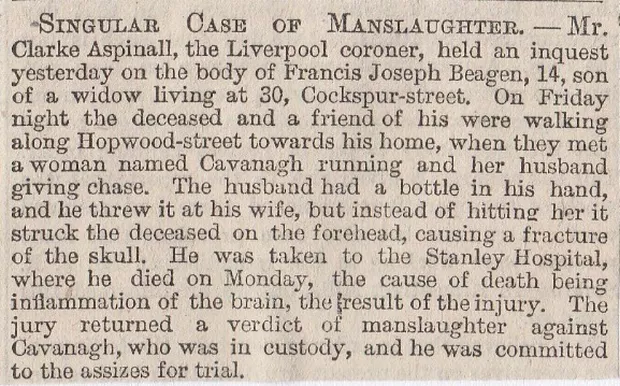
134/ Wavertree, (Child Murder/Suicide) October 1850
This is an inquest on the bodies of Catherine Carnall, a housemaid to Francis Hollins Esq. of Cow Lane, and of her infant child, which she had buried in the privy. She then committed suicide by taking vitriol. It seems that she went to Mr Hollins and confessed to the birth, then ran out of the house and made a dash for the pond, but Hollins reached her in time and put her in his parlour. She was let out later to get something to eat from the pantry and it was here she got the vitriol and swallowed some of it. The verdict was “Temporary Insanity.”
135/ Liverpool Pub Suicide, February 1856
David Moffatt aged twenty-one-years, arrived in Liverpool on an Irish steamer and headed straight for a public-house in Bridport Street. The staff noticed that he was agitated about something and he told the landlord that he was the son of the Rev C.Moffatt of Newry and that he’d been a wicked lad and had got his father’s servant up the duff. Friends of his were against him marrying her, so he came to Liverpool to get away. He took a room for the night and when they found him next day he had a huge gash along his throat. He was alive but only just. When asked who had done it to him, he replied “Myself”, then died. Property in his baggage proved that the lad was telling the truth about his family and where he was from. (What pub?)
136/ George Thomas Execution, December 1885 (See No 123, above)
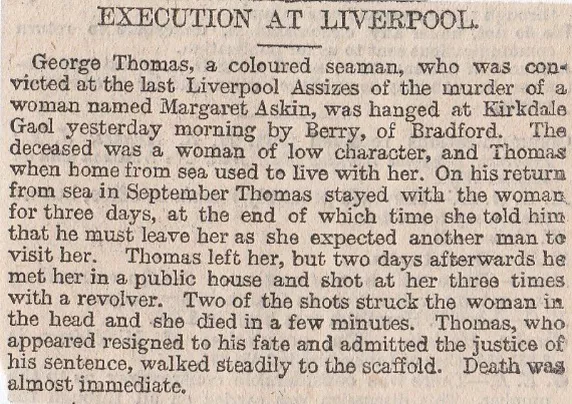
137/ Walton Gaol Suicide, May 1885

138/ Eastham Ferry Drownings, June 1885

139/ York Street Tragedy, Liverpool July 1870 (York Street today (2018) is like a Victorian road would have been)
140/ Earlestown Railway Death, near Newton-le-Willows September 1870.
At an inquest held in Liverpool yesterday, on the body of a man named Henshaw, a singular case of accidental death was brought to light. According to the evidence, the deceased had been apprehended at Earlstown on Monday night by a servant of the London and North-Western Railway, on a charge of riding without a ticket between Edge Hill and Earlstown, and while endeavouring to escape by jumping on a train just about to start, he fell on the line, and was run over by some of the carriages. He was so badly injured that he died the same night.
141/ Barton Moss Fatal Shooting, September 1870
142/ Altcar Rifle Range Fatality, November 1870
On Saturday afternoon two parties of the 64th Lancashire Rifle Volunteers were firing at separate targets at the Altcar rifle range. The weather being foggy, Richard Wheatley, a militia sergeant attached to the corps, went some distance in advance from the usual place to see the efforts of the firing, when by some mishap a stray ball passed through his head and killed him on the spot. The occurrence created a very painful sensation throughout the corps, by all members of which the deceased was greatly respected.
143/ Liverpool Town Hall Death, October 1870
A painful incident occurred at a conference of ministers and laymen held in Liverpool Town Hall, for the purposes of the “Hospital Sunday” movement in that town. The Rev. T.C. Cowan, incumbent of St Chrysostom’s, Everton, was speaking in support of a motion in favour of special Sunday’s collections when he fell backwards in an apoplectic fit and expired before he could be removed into an adjoining room. A most solemn impression was produced by the event, and the Mayor at once adjourned the meeting. Mr Cowan was about sixty years of age. He was said to have been subject to angina and was told by doctors to avoid excitement and fatigue.

